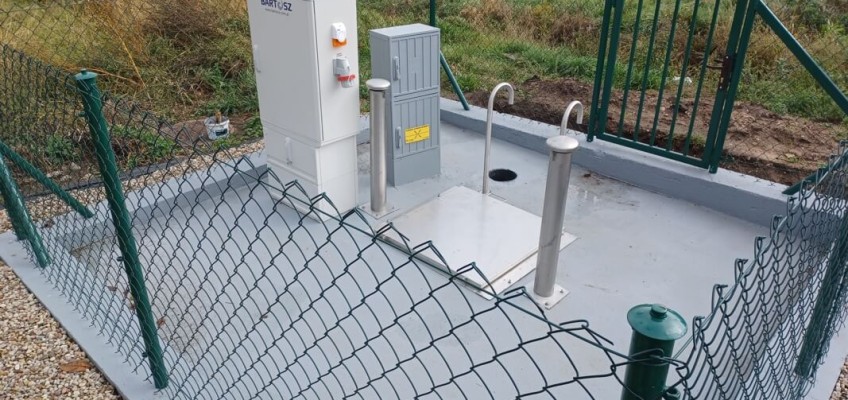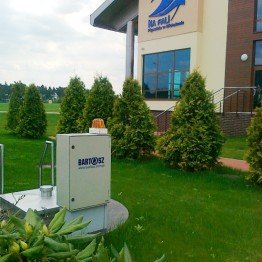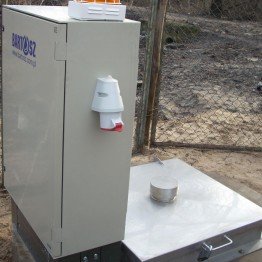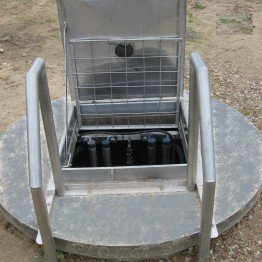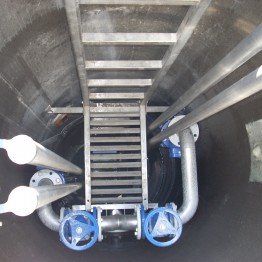The modern pumping stations produced by Firma Bartosz are used when constructing sanitary, industrial and storm sewers in cities, villages and manufacturing plants. This is one of the most important parts of water and wastewater management. Their main function is the transport of sanitary wastewater, drainage water and stormwater as well as the water from dewatering processes over long distances or to a much higher level. The pumping station is supposed to pump the wastewater into the main manifolds of the gravitational or delivery (pumping) sanitary sewer. In the standard version, the chambers are made in the form of cylinders with sealed bottoms, however, large tanks can be made in the oval form or other shapes.
The pumping station chambers are available in the following versions in terms of material:
- HDPE
- Polymer concrete
- “Betras” type pipes
- Polyester resins reinforced with fibre glass
- Steel
- Concrete rings as well as concrete reinforced on-site
Tank equipment:
- Pumps: they constitute the basic element of a hydraulic system. The tank pumping stations are available in one-, two- or three-pump versions. The selection of pump depends on the maximum inflow of wastewater and its type, the geometric lift as well as the sum of losses within the discharge pipeline. The pipeline sizes should be selected in such a manner so as to ensure a minimum speed of self-cleaning:
- for discharge risers within the pumping station, the speed should not be less than 1 m/s or more than 2.5 m/s;
- for horizontal pipelines outside the pumping station, the speed should not be less than 0.8 m/s or more than 3 m/s.
Within our wastewater pumping stations, we apply pumps of the following manufacturers: ABS, EMU, MEPROZET, KSB, GRUNDFOS, LFP, FLYGT, WILO, SIGMA, METALCHEM or HIDROSTAL. On request, we can also provide devices from other manufacturers.
Pumping station standard equipment:
- Discharge risers, collecting discharge manifold: the wastewater is delivered from the pump to the discharge manifold through a discharge riser made of stainless steel. The diameter of the discharge risers depends on the size of the pumps applied and their performance. The following cast iron fittings are installed on the discharge riser: a check valve – a ball valve with an access allowing for its cleaning, a gate valve with a rubber wedge. The check valve prevents the backflow of the pumped wastewater, and the gate valve allows for the closure of the wastewater flow.
- Liquid level control: as a standard, float level sensors which are mounted on a stainless steel chain with weights are applied in pumping stations. The floats are hung on a hook mounted on the top cover of the tank.
- Ladder: in order to allow the operating personnel to enter the pump interior, a ladder made of galvanised steel (fire- or acid-resistant on request) has been mounted to the housing.
- Pumping station ventilation:it is performed by gravity, by means of air supply and exhaust pipes ending with ventilators elevated above the ground level, which are lead directly from the pump station cover or the tank walls. This provides gravitational air circulation. Optionally, we can mount the biofilter which neutralises odours or a mechanical ventilator.
- Manhole: the manhole is located within the top cover of the tank. Its size allows for easy installation and maintenance of pumps, fittings and discharge risers. A ventilation grate is mounted under the cover, constituting protection for a period of weathering the pump station interior.
When installing a pumping station within roadways, pavements or squares, where traffic takes place, the tanks are made in a version adapted to execute the construction with a load distribution plate.


